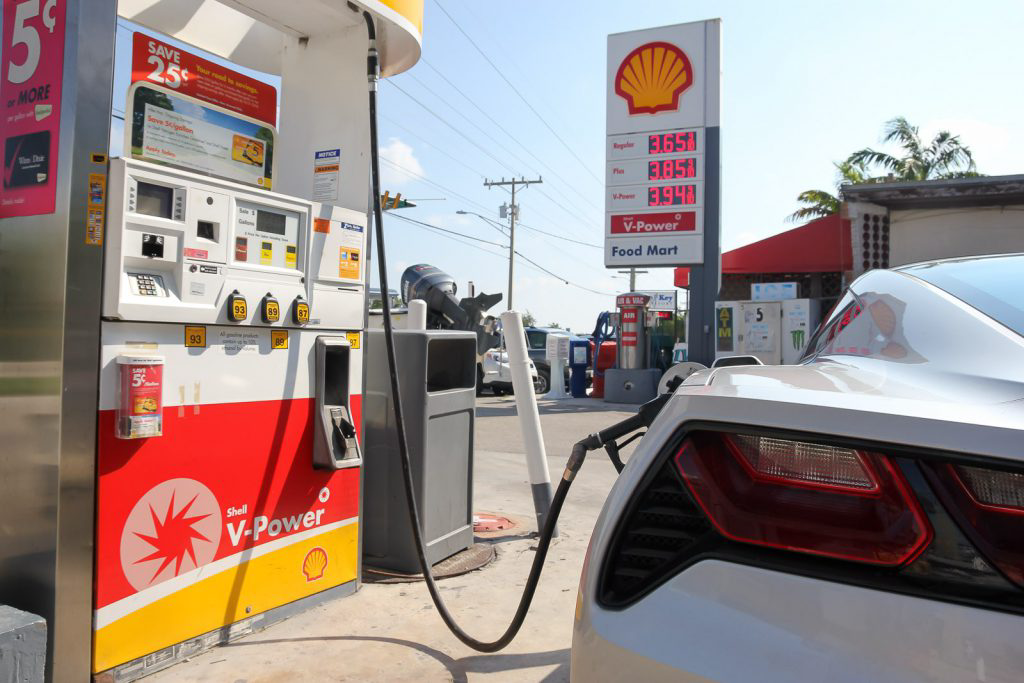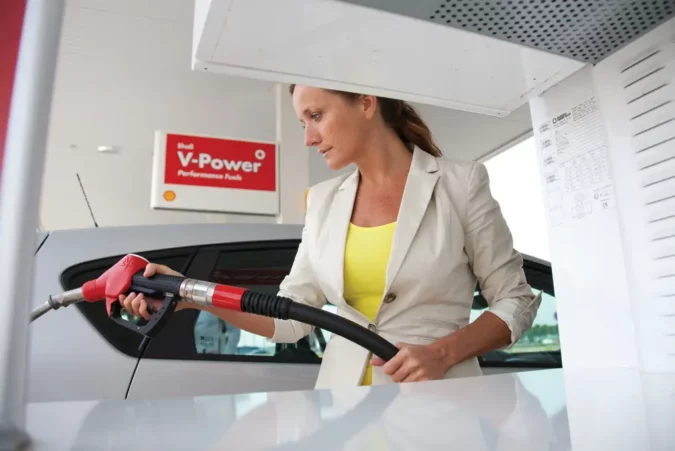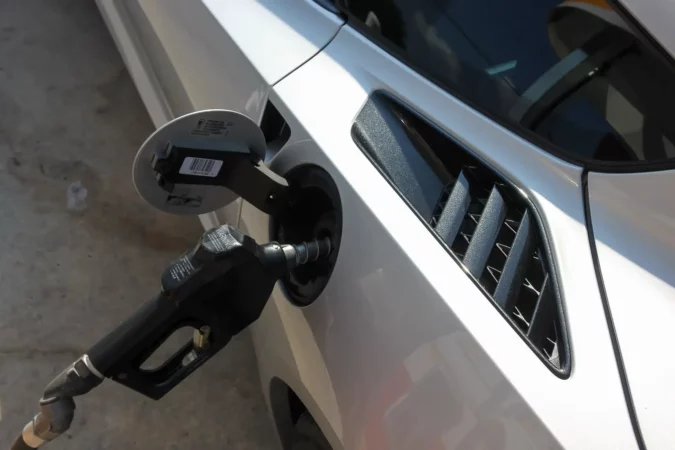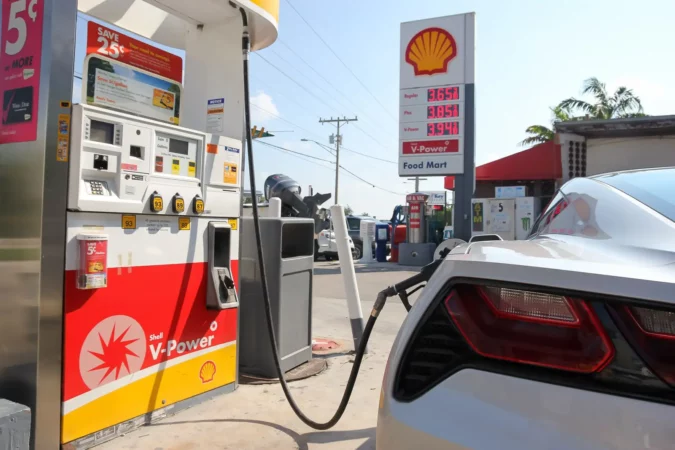Visiting the gas station is a weekly tradition for every gearhead, at least to the ones that haven’t already made the jump to an electric car yet. Although it is an age-old tradition, filling up a car at the gas station still has some urban legends associated with it. Tell us, how many of your turn the car off before filling it up? Can you pump gas with the car on? What is the science behind this?
After going through this article, you can decide for yourself whether to keep the engine on or off the next time you visit the fuel pump. So, without further ado, let’s dive right into our discussion.
As a start to this article, we thought of looking into how a gas pump operates. There’s a surprising number of myths associated with filling up, such as the myth surrounding Top Tier gas. We are sure you haven’t spared thought about this process before. Feeling curious? If so, follow us along!
How Does A Gas Pump Work
Before focusing our attention on the question “can you pump gas with the car on?”, let us look into the internal operation of a gas pump. You see, there are several components that work in harmony to pump gas into your vehicle. They are;
- Underground Storage Tanks
- Check Valve
- Fuel Flow Meter
- Blend Valve
- Automatic Shut-Off
Let us focus our attention on each of these components. This will help you understand the key roles each of them plays when you go to top up your car’s fuel.
1. Underground Storage Tanks
Have you ever wondered where thousands of liters of gasoline are stored in a fuel station? Let us answer that question for you!
Most fuel stations have at least two massive underground tanks specifically designed for fuel storage. The different tanks hold different grades of fuels, and the liquid is pumped to the surface using a pump. To find out more about how this all works, do head over to our write-up on how much does a gas station cost.
There are two main types of pumps commonly used at gas stations, including the best gas station around. The first type is submersible pumps. As the name suggests, these pumps are submersed below the fuel level. They use a device called an impeller to pump the fuel onto the surface and out the nozzle.
However, suction pumps are the more common type of fuel pump used in gas stations. Instead of an impeller, these use unequal pressure to move the fuel. Here, the fuel is brought to the surface by removing the air and creating a vacuum. As most storage tasks lay only a few feet below the gas station’s surface, suction pumps can be seen as the more logical choice.
2. Check Valve
We already established that a pump pushes the fuel from the underground tanks to your vehicle on the surface. But, what happens to the fuel inside the pump once the motor is turned off?
It would be a big issue if the fuel simply falls back into the tank itself. Instead, there is a check valve inside the pump that retains the fuel.
It does this by forming an airtight seal above the gas levels. The process of withholding the fuel within the pump itself is referred to as keeping the prime.
Now you might wonder why fuel pumps come with check valves in the first place. Well, you see, there are two main reasons. The first is to ensure a constant supply of fuel to the customers. Preventing wear and tear on the pump is the second reason for keeping the prime.
3. Fuel Flow Meter
The flow meter is the third main fuel pump component we’ll be looking at here today. This is what keeps track of how much fuel you have pumped into your gas tank. Granted, this might not be as much of an issue if you live in states where you can’t pump your own gas, or wonder why can’t you pump your own gas in NJ.
As the fuel travels upwards from the underground tank, it goes through a flow control valve. This valve controls the speed of fuel flow using a plastic diaphragm. Next up is the fuel flow meter, which is typically made using either an aluminum or cast iron chamber with a rotor and a series of gears inside.
However, there is some high-tech equipment within the fuel pump mechanism too. The dispenser contains an inbuilt computer, which displays the amount of fuel accurately to the tenths.
Although this system works perfectly on most occasions, there may be some situations where it experiences difficulties.
The external temperature has a significant impact on the accuracy of this equipment. During hot to cold weather, the density of the fuel may undergo changes. When this happens, the flow meter will give out wrong measurements. Luckily, the computer is smart enough to compensate for these errors.
The fuel flow meter should be periodically inspected to keep it in good condition. If there are issues, the meter has to be recalibrated or replaced entirely with a brand-new one. The National Institute for Standards and Technology (NIST) issues the regulations and guidelines for fuel flow meter recalibration.
4. Blend Valve
When it comes to fuel, gas stations offer vehicle owners various choices. There can be as many as five different gas grades, with each having a different Octane rating. However, contrary to popular belief, there aren’t always five different underground tanks dedicated to each fuel type.
Typically, there are only two types of fuel stored in underground tanks. One with the highest Octane level, and another with the lowest. These two types are blended together in various compositions to produce different Octane level fuels.
This blending process is done through the use of a blend valve. There are two inputs to this valve, as well as a movable barrier called the “shoe” This shoe can be moved across either direction through the use of a motor-driven ratchet. The movement of the shoe by shifting the ratchet is what produces the different Octane grade fuels.
5. Automatic Shut-Off
The gas station is one place where you don’t want to cheap out on safety features, especially once you hand over the responsibility of pumping gas to cars to their owners. All it takes is one spark, and everything could go up in flames. The automatic shut-off is one safety measure.
Usually, the fuel flows from the pump to your vehicle stops once you release the lever. But, what if it malfunctions? If that happens, there is a high chance of the fuel overflowing and creating a fire hazard.
This is where the automatic shut-off comes into play. There is another small pipe called the venturi that runs alongside the gas nozzle you hold in your hand. Using this pipe and air pressure, the pump can detect potential gas overflows and cut-off before it spills.
Keep these components in mind the next time you visit the gas station to pump gas into your car. Now that you know all about the inner workings of a fuel pump, let’s shift our attention to the fuel system of your vehicle.
Car Fuel System
When you attach the gas nozzle to your car and pull the lever, gasoline or diesel stored in the underground tanks fills your vehicle’s fuel tank. This tank is usually situated at the rear of a vehicle and can hold between 45 to 65 liters. But, this fuel capacity may vary depending on the type, make, and model of your ride. This also impacts how long does a full tank of gas will last you.
From the fuel tank, the gasoline flows through a fuel filter on its way toward the engine. The fuel filter is responsible for removing fine particles contained within the gasoline. If unfiltered, these small contaminants carry the risk of damaging the engine internals. Additionally, they can increase the harmful emissions from the engine too.
To find out more, do check out our extensive guide on the symptoms of a bad fuel filter, and the process around a fuel filter replacement.
After passing through this filter, the fuel gets to the injectors. Modern vehicles rely on them to pressurize the fuel and squirt it into the intake port or directly to the cylinder itself. Elsewhere, older vehicles come with carburetors that have a similar intention. Our guides on dirty fuel injectors, the symptoms of a bad fuel injector, and fuel injector replacement cost has more context.
Do you hear a slight whine when you turn the key inside the ignition? What you hear is the fuel pump turning on. All modern cars have fuel pumps driven by electricity, while older models had to do with rudimentary mechanical fuel pumps. These used a vacuum to make the fuel flow through the intake port and into the engine.
Should you need to understand more about fuel pumps, do check out our resources on the symptoms of a bad fuel pump, as well as the fuel pump replacement cost.
Flammability And Flashpoint of Gasoline
When looking for an answer to “can you pump gas with the car on?” we came across some interesting facts about gasoline itself. Are you curious to learn them too? If so, follow along!
Gasoline and diesel are highly flammable liquids. This is why you have to handle it with care and pay close attention to it when deciding whether you can pump gas with the car on. But, did you know that gasoline is really hard to ignite on its own in liquid form? Without a catalyst, gasoline has to be heated over 476.6°F to be ignited on its own.
However, this does not mean that you can go and simply pump fuel (once you understand how to pump gas) with the car on. What makes gasoline dangerous is its flashpoint. The flashpoint refers to the temperature at which gasoline releases enough vapors that carry the risk of being ignited in the air. We’ve discussed this before in our guide on can gas freeze, as well as at what temp does diesel freeze.
This figure sits at a very low -45°F, meaning that it can ignite even at freezing temperatures. On the other hand, diesel has a higher and much safer flashpoint of around 100°F. This extremely low flashpoint is what makes gasoline so suitable to be used in internal combustion engines.
Can You Pump Gas With The Car On?
With that, let’s shift our attention toward the elephant in the room, which is whether or not you can pump gas with the car on. Simply put, there are many risks associated with pumping gas with the engine running. Some of the most significant ones include;
- Fire
- Fuel Spills
- Static Electricity
- Gas Poisoning
Let us dive into each one of these risks. Hopefully, this information will deter you from fueling up your car while your engine is running in the first place.
Can You Pump Gas With The Car On, Risks #1 – Fire
The first and most destructive risk of pumping gas with the car’s engine on is fire. You see, three elements have to come together in order for combustion to occur. The fuel, air, and a source of heat. A gas station is a prime spot where all these three elements are abundant.
Although letting the car run isn’t as dangerous as bringing an open flame near a fuel pump, it still carries the risk of being the catalyst to a massive fire. There are many places on a car that can easily create sparks. The spark plugs are perhaps the most obvious ones.
Igniting the fuel/air mixture to create power is the main responsibility of the spark plugs. Each of these tiny components can create thousands of volts. Although spark plugs come from the factory with good insulation, there is always the risk of some electricity contacting the gasoline vapors outside.
To learn more about spark plugs, we have resources on what do spark plugs do, in addition to what does a bad spark plug look like, and how to check spark plugs, as well as the symptoms of a bad spark plug.
The catalytic converter is another potential source of engine fires. Located at the back of the exhaust system, the catalytic converter removes some highly toxic materials from the exhaust before releasing them into the environment.
Due to the nature of its operation, the catalytic converter gets really hot. In fact, the temperature often exceeds 1500°F. As you can already guess, it can be catastrophic if even one tiny drop of fuel finds its way onto the catalytic converter.
Can You Pump Gas With The Car On, Risks #2 – Fuel Spills
Sometimes, filling up your vehicle with the engine on can make the fuel spill out. Although it might not seem like a big deal, there are still some risks associated with it.
If the spilled fuel gets on your body, it can cause skin irritations. Additionally, the odor of gasoline might be nauseating to some people. On the other hand, spilling gasoline on your car can damage its paint. This might be what causes you to worry about the cost to repair a paint chip on a car, as well as how to fix chipped paint on a car, in addition to how to fix peeling paint on a car.
Considering these negatives, pumping gas with the engine running doesn’t seem like such a good idea, right?
Can You Pump Gas With The Car On, Risks #3 – Static Electricity
Static electricity is another dangerous hazard associated with pumping fuel with the engine running. It can be generated by almost anything and can lead to a flash fire if you aren’t careful enough.
Letting the car run while fueling up greatly increases the risk of static buildup. Although the chances of a fire due to static are extremely low, it is always better to be safe than sorry. If you are worried about static buildup, simply touch the car before plugging in the fuel nozzle. Doing so will discharge all the static electricity that has already been built up.
Can You Pump Gas With The Car On, Risks #4 – Gas Poisoning
Gas poisoning is another relatively unknown risk of pumping gas with the engine running. When pumping fuel, harmful vapors escape the gas tank and make their way into the air. These are very dangerous and can cause a whole host of health issues.
Although most vehicles come with a vapor recovery system to keep rouge fuel vapors at bay. Yet, it is better to be safe than sorry, and we recommend you turn off the engine when filling up. Otherwise, the gas cap does a great job on its own to seal the gas tank, and prevent vapors from seeping out.
So, if you notice anything akin to a gas cap check engine light (or a P0455 code or a P0442 code – just like the P0442 code Chevy Silverado), or a ‘check fuel cap’ warning on your Honda Accord, or trying to figure out what does a ‘check fuel cap’ warning mean, it’s worth considering a gas cap replacement.
Is It Illegal To Pump Gas With Engine On
Even if you are someone who is ready to accept the risks of pumping gas with the engine on, there is another reason not to do it. In the United States, there is a law stating that “No internal combustion engine fuel tank shall be refilled with a flammable liquid while the engine is running.”
In other words, the law prohibits you from leaving your vehicle while it is being refueled. This is not specific to the United States, as other countries like the United Kingdom also have similar laws implemented.
How To Pump Gas Correctly
Hopefully, now you understand why it is a bad idea to keep the engine running when pumping fuel. But, do you know the correct way to do so? Here, we’ll give a step-by-step guide on how to pump gas correctly into your vehicle. We also have a more detailed guide on how to put gas in a car.
Before pulling up to the fuel pump, correctly identify the side in which the fuel cap is located. This will save you from a lot of hassle and embarrassment later on. Some cars have a small triangle next to the gas symbol on the dashboard which indicates the side of the fuel filler cap.
When parking next to the pump, make sure to keep the wheels straight. This will help you when pulling out. Turn the engine off, and open the gas lid. Next, unscrew the fuel filler cap, and push the fuel nozzle into the gas tank. Make sure that you have selected the correct type of fuel for your vehicle before grabbing the lever to make fuel flow.
Once the gas tank is full, the nozzle will stop the fuel flow automatically. However, you can also stop filling up by letting go of the lever prematurely. After the vehicle is filled up, put the nozzle back and tighten the gas cap before closing the lid. Then, you can pay the bill and be on your way!
Gas Station Rules
We already established that if you aren’t careful, the gas station can become a pretty dangerous place. You also learned that keeping the engine turned on while pumping gas is not a good idea. With that, let’s shift our attention toward some other rules you should follow at the gas station.
1. Smoking Is Not Allowed
Even the smallest of sparks can cause a mighty disaster at a gas station. The fuel vapors light up surprisingly quickly and may result in a ball of fire. With that, it is no wonder that smoking is prohibited at all gas stations.
Almost all gas stations have warning signs saying not to smoke in the vicinity. So, be a responsible driver and refrain from smoking at gas stations.
2. Only Use Approved Gas Cans
You must be extremely cautious when transporting fuel. That’s why we recommend only using approved containers for this. To make differentiating gas cans easier, they come color-coded from the manufacturer.
If you want to transport gasoline, go for a red-colored container. Yellow ones are made for diesel, while blue ones are made for kerosene transportation. Additionally, canisters made to hold oil are green in color.
Make sure to use the correct type of container for the fuel of your choice to avoid any mixups and mishaps. For more context into the right type of container or gas can to use, do check out our guide on how to dispose of old gas.
Verdict
Although keeping the engine turned on while pumping gas seems like a great way of saving some time, the dangers associated with it are far greater. Fires can occur due to static buildup, or a tiny spark from the engine. So, it is important that you follow the correct safety procedures when visiting the gas station.
To be frank, our answer to the question “can you pump gas with the car on?” is a firm and resounding “No!”
Frequently Asked Questions
If you’re curious to learn more about can you pump gas with the car on, our FAQs here might help…
How To Pump Gas
Pumping gas is something that every driver is capable of doing. Simply pull up next to the pump, remove the gas cap, put the nozzle in, and pull the lever to start pumping. However, make sure to turn your car off before doing so.
Can You Leave Your Car On While Pumping Gas
Pumping gas with the engine running is something you should avoid at all costs. Not only is it dangerous, but it can get you into trouble with the law as well.
How Long Can Gas Sit In A Car
Gasoline is not meant to be in your vehicle’s fuel tank for long stints on end. Generally, the maximum amount of time gas can sit inside a fuel tank is considered to be three to six months. However, diesel has a comparatively longer shelf life of up to a year.
What Happens When You Run Out Of Gas
The first thing that happens when you run out of gas is the engine tuning off. The hydraulic assistance to the brakes and steering wheel will also seize due to the engine shutting off.
How Does A Gas Pump Know When To Stop
The gas line inside the pump has another smaller pipe called the venturi that runs alongside it. As the gas levels rise, the end of this venturi pipe submerges in the fuel. This chokes off the air pressure, stopping the gas from flowing further.






